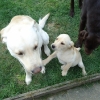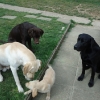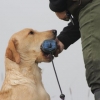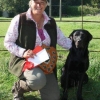Breeding: ‘Inbreeding’, ‘Linebreeding’ and ‘Outcrossing’ Explained
Especially relevent recently with much misunderstanding ‘out there’ about pedigree dog breeding after the BBC programme.
————————————————
…………. I had a nice conversation with a lady this afternoon, which is a repeat of many many similar slightly concerned conversations I have had with potential and actual puppy buyers through the years.
The concern was that when they looked at their dogs pedigree, many of the same dogs, or the same kennel names turned up throughout. There was a genuine and understandable fear that the old word ‘inbreeding’ that is used so much to supposedly blame for every problem known to dogs could be applied to their dogs pedigree.
Let me just explain for information rather than mocking anyone at all who secretly wondered about this:
As a breeder when you decide to mate your bitch there are three avenues open to you.
1) OUTCROSSING. This is usually done without even knowing what it is called by many many novice or unethical breeders. It is the catagory that simply picking a stud for your bitch because he lives nearby, or is the same colour, or happens to have an owner who ‘thinks its time he was a father’ etc etc falls under. HOWEVER Outcrossing can also be a GOOD and wholey ethical thing. It can be a planned mating for many positive reasons between two dogs who just simply do not share hardly or any ancestors or relatives. In our breed the gene pool is enormous and therefore it is very EASY to outcross. Your bitch may be lacking in a certain area of conformation or temperament that is common to her line. Outcrossing somewhere entirely different to dogs that are STRONG in the area she lacks can benefit the offspring enormously.
Pet owners tend to like outcrossing (even if they did not know it was called that). They often seem to think seeing the same dogs in a pedigree is a BAD THING. So seeing none who are related must be a GOOD THING. Hopefully above shows that depends on the reasons behind the dogs selected for the breeding.
2) LINEBREEDING. We move on to the middle ground option. Linebreeding tends to be the chosen route of most competition breeders for most matings (unless, as mentioned above, they wish to breed out a negative trait in their line and need lots of fresh blood in to do this). Line breeding is selcting two dogs to mate who share many of the same lines. The good thing about this is you have a very good idea of what will result from this mating. Two dogs of alike type and pedigree will generally produce puppies alike again. Generally the idea of breeding for competition dogs (and indeed ANY good mating)is that you are trying to select a sire to mate your bitch who can contribute positives and better the quality of the mother in the puppies produced. Lienbreeding to a good strong dog who shares your good bitches lines can be extremely successful in achieving this. Most champions in the ring and field today are bred using the linebreeding method.
So seeing several of the same dogs or kennel names in a pedigree usually shows the dog has been bred thoughtfully and with a knowledge of the lines and dogs behind the parents being mated. Of course that doesn’t mean outcrossing doesn’t produce good dogs, but they can be a mish mash of both lines used and rather an unknown quantity.
LINEBREEDING IS NOT INBREEDING.
Which neatly moves me to:
3) INBREEDING.
Thought of as bad by nearly everyone except the very experienced breeders who CAN and DO use it sucessfully. Inbreeding is specifically catagorized as mother to son, father to daughter, brother to sister. Borderline inbreeding is grandparent to grandchild and half brother to half sister (so dogs who share the same, say, father but a different mother).
Just seeing lots of the same dogs dotted within a 5 or 6 generation pedigree is not nearly the same as seeing one of the above, very tight matings. This and this only is inbreeding. As previously mentioned, the Labrador gene pool is very large, inbreeding is very very rarely practised by experienced breeders. However it CAN sometimes be practised by lazy or inexperienced breeders or by accidental matings. It does, of course, have its dangers in the sense that dogs will NOT be born with two heads or five tails BUT any of the health problems which are PROVEN to be directly recessively inheritable, which currently only stands directly as the eye problems in the breed (hip and joint problems are polygenetic meaning they have several related factors which go towards causing them), could occur with a far greater frequency in inbreeding matings as one opens oneself up to the same genes being placed together so closely.
In SMALL breeds inbreeding is used fairly often as they have such a small choice of mateable dogs. Superb results can occur when used on superb dogs (and I MEAN superb) by breeders who know their lines 101% and all the various in’s and out’s of undertaking such matings. Generally speaking such matings should be avoided by inexperienced or novice breeders, or even middle grounders as there are SO many other choices open to us, why take any extra risks?
So I hope this makes it clearer and the word ‘inbreeding‘ will not be something anyone reading will now consider when looking at a lovely ‘linebred’ pedigree with many of the same dogs and lines contained.
Diana Stevens – 2007







